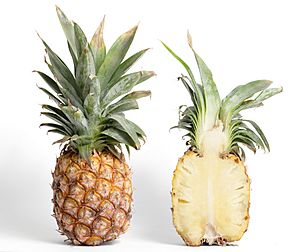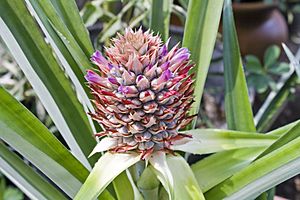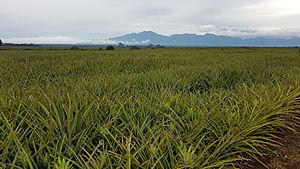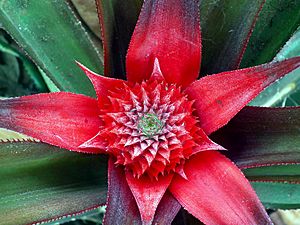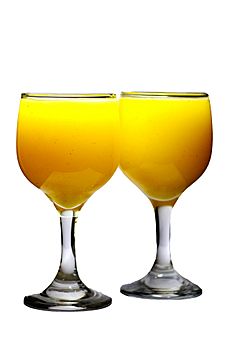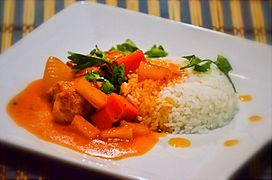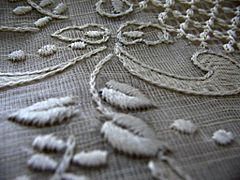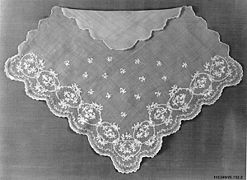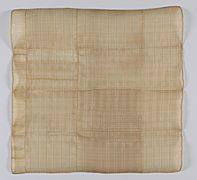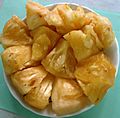Pineapple facts for kids
Quick facts for kids Pineapple |
|
|---|---|
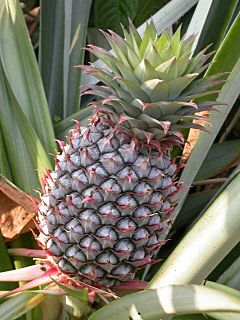 |
|
| A pineapple, on its parent plant | |
| Scientific classification | |
| Kingdom: | |
| Division: | |
| Class: | |
| Order: | |
| Family: | |
| Subfamily: |
Bromelioideae
|
| Genus: | |
| Species: |
A. comosus
|
| Binomial name | |
| Ananas comosus (L.) Merr.
|
|
| Synonyms | |
|
Ananas sativus |
|
The pineapple (Ananas comosus) is a tropical plant known for its yummy, edible fruit. This fruit is also called a pineapple! It's the most important plant in the Bromeliaceae family, which includes many other interesting plants.
You can grow new pineapples from the leafy top of a fruit. It might take five to ten months for the plant to flower. Then, the fruit will grow over the next six months. Pineapples don't get much riper after they are picked. In 2016, countries like Costa Rica, Brazil, and the Philippines grew almost a third of all the pineapples in the world!
Contents
- What's in a Name?
- Pineapple's Journey Through History
- How Pineapples Grow
- How Pineapples are Pollinated
- Types of Pineapples
- How We Use Pineapples
- Pineapple Production Around the World
- Growing Pineapples
- Storing and Transporting Pineapples
- Pineapple's Meaning and Culture
- Gallery
- Pineapple Health Benefits
- Images for kids
- See also
What's in a Name?
The word "pineapple" first described the cone-shaped parts of conifer trees, like pine cones. When European explorers found this tropical fruit in the Americas, they thought it looked like a pine cone. So, they called it a "pineapple" in 1664.
The scientific name for pineapple is Ananas comosus. The word ananas comes from a Tupi word, nanas, which means "excellent fruit." This name was first written down in 1555. The word comosus means "tufted," which describes the leafy top of the fruit.
Pineapple's Journey Through History
The pineapple plant first grew in South America, likely between southern Brazil and Paraguay. Native people from southern Brazil and Paraguay helped spread the pineapple across South America. It eventually reached the Caribbean, Central America, and Mexico. The Mayas and Aztecs also grew pineapples.
In 1493, Christopher Columbus found pineapples on the island of Guadeloupe. He called it piña de Indes, meaning "pine of the Indians." He brought it back to Spain. This made the pineapple the first plant from the bromeliad family to be taken out of the Americas by humans. The Spanish then introduced pineapples to places like the Philippines, Hawaii, Zimbabwe, and Guam. The Portuguese took the fruit from Brazil to India around 1550.

The Dutch brought pineapples to northern Europe from their colony in Suriname. The first pineapple successfully grown in Europe was by Pieter de la Court in 1658.
In England, the first pineapple was grown in Dorney Court. A special heated building called a "pineapple stove" was built in 1723 to grow them. In France, King Louis XV received a pineapple grown at Versailles in 1733. Catherine the Great in Russia also ate pineapples grown on her own land.
Because it was so expensive to bring pineapples from far away or grow them in heated hothouses, they became a sign of wealth. Rich people would often display pineapples at dinner parties instead of eating them. They would use the same fruit again and again until it started to rot! By the late 1700s, growing pineapples became a competition among wealthy people in Britain. One aristocrat, John Murray, 4th Earl of Dunmore, even built a hothouse shaped like a giant pineapple, known as the Dunmore Pineapple.
John Kidwell helped start the pineapple industry in Hawaii. Large-scale pineapple farming by US companies began in the early 1900s. James Dole was a very famous pineapple grower. He moved to Hawaii in 1899 and started a pineapple farm in 1900. Companies like Dole and Del Monte began growing pineapples on the island of Oahu in 1901 and 1917. Dole's company started with 60 acres of land and grew into a huge business. The Maui Land & Pineapple Company started growing pineapples on the island of Maui in 1909.
In 1986, the Pineapple Research Institute in the US closed. Its special pineapple types were divided between Del Monte and Maui Land and Pineapple. Del Monte took a type called 'MD-2' to its farms in Costa Rica. They found it grew very well there and started selling it in 1996 as 'Gold Extra Sweet'.
Dole stopped its pineapple canning operations in Honolulu in 1991. In 2008, Del Monte also stopped growing pineapples in Hawaii. By 2013, only the Dole Plantation on Oahu still grew pineapples, but it was a very small amount compared to the world's total.
The 'Red Spanish' type of pineapple was also widely grown in the Philippines for making textiles since at least the 1600s. These plants were brought to the islands from Latin America during the Spanish colonial period. Later, the 'Smooth Cayenne' type was brought in the early 1900s. Dole and Del Monte also set up farms on the island of Mindanao in the 1920s. The Philippines is still one of the top pineapple exporters today.
How Pineapples Grow
The pineapple is a herbaceous perennial plant. This means it's a plant that doesn't have a woody stem and lives for more than two years. It usually grows to be about 1 to 1.5 meters (3 to 5 feet) tall. The plant has a short, thick stem with tough, waxy leaves.
When it's time to make fruit, a pineapple plant usually produces up to 200 flowers! These individual flowers then join together to form one large, single fruit. After the first fruit grows, new shoots (called 'suckers') grow from the main stem. Farmers can remove these suckers to grow new plants, or leave them to produce more fruits on the same plant. For commercial growing, suckers that appear around the base of the plant are often used.
The plant has 30 or more long, narrow, fleshy leaves. These leaves are shaped like a trough and have sharp spines along their edges. They can be 30 to 100 centimeters (1 to 3 feet) long and surround a thick stem. In its first year, the stem grows longer and thicker, with many leaves arranged in spirals. After 12 to 20 months, the stem grows a spike-like flower cluster up to 15 centimeters (6 inches) long. This cluster has over 100 flowers arranged in spirals.
The parts of the flowers that hold the seeds develop into berries. These berries then join together to form the large, compact pineapple fruit we eat. If you look closely at a pineapple, you'll see its pattern is made of two sets of interlocking spirals. One set has 8 spirals, and the other has 13. These numbers are part of the Fibonacci sequence, which is a cool pattern found in nature!
Pineapples also have a special way of taking in carbon dioxide, called CAM photosynthesis. They take in carbon dioxide at night and store it. Then, during the day, they use it for photosynthesis, which helps them grow.
How Pineapples are Pollinated
In the wild, pineapples are mostly pollinated by hummingbirds. Some wild pineapples are also visited and pollinated at night by bats.
When pineapples are grown on farms, farmers usually don't want seeds to develop in the fruit because seeds can make the fruit less tasty. So, pollination is often done by hand, or sometimes avoided altogether. Seeds are only kept for breeding new types of pineapples. For example, in Hawaii, where pineapples were grown and canned a lot in the 1900s, it was against the rules to bring in hummingbirds. This helped prevent the pineapples from being pollinated and developing seeds.
Types of Pineapples
There are many different types of pineapples around the world, more than a hundred! They also come in various sizes. Here are four main types:
- Sugarloaf pineapple: This type often grows in Mexico and Venezuela. It has white flesh and is not woody inside.
- Red Spanish pineapple: You can find this one in Central American countries. It has pale yellow flesh and a square-like shape.
- Queen pineapple: This variety grows in the Hluhluwe region of South Africa. It's less sweet, but its flesh is rich and yellow. It has a mild flavor.
- Smooth Cayenne pineapple: This type comes from Hawaii. It has a high sugar and acid content. Its leaves don't have spines, and the fruit is shaped like a cylinder.
How We Use Pineapples
Pineapple in Food
People all over the world use the flesh and juice of pineapples in their cooking. In many tropical countries, you can buy pineapple prepared as a snack on the side of the road. It's often sold whole or in halves with a stick. Slices of pineapple with a cherry in the middle are a common decoration for hams in Western countries.
Pineapple chunks are used in desserts like fruit salad. They also appear in savory dishes, such as pizza toppings or as a grilled ring on a hamburger. Traditional dishes that use pineapple include hamonado, afritada, kaeng som pla, and Hawaiian haystack. Crushed pineapple is used in yogurt, jam, sweets, and ice cream. Pineapple juice is a popular drink and a key ingredient in cocktails like the piña colada and in the drink tepache.
From 2012 to 2016, countries in the European Union drank half of all the pineapple juice produced globally. The Netherlands was the biggest importer of pineapple juice in Europe. Thailand, Costa Rica, and the Netherlands were the main suppliers to Europe during that time. In 2017, the countries that drank the most pineapple juice were Thailand, Indonesia, and the Philippines. These three countries together consumed 47% of the world's total. The biggest increase in pineapple juice drinking from 2007 to 2017 was in Angola.
-
Chicken afritada from the Philippines.
-
Tepache, a traditional Mexican drink.
-
Pininyahang manok, a Filipino chicken dish with pineapple.
-
Pineapple pizza.
-
Kaeng som pla, a sour curry from Thailand.
Pineapple in Textiles
The 'Red Spanish' type of pineapple was once widely grown in the Philippines for its leaves. These long leaves were used to make traditional piña fibers. These fibers were woven into shiny, lace-like nipis fabrics. These fabrics were often decorated with beautiful flower designs called calado and sombrado.
Piña fabric was a luxury item exported from the Philippines during the Spanish colonial period. It became popular among rich European families in the 1700s and 1800s. In the Philippines, it was used to make traditional clothes for the upper class, like the barong Tagalog, baro't saya, and traje de mestiza. It was also used for women's kerchiefs (pañuelo). People liked these fabrics because they were light and airy, perfect for the hot tropical climate. The industry was damaged during World War II and is only now starting to come back.
-
An early 19th-century pañuelo at the Metropolitan Museum of Art.
-
A 19th-century cotton and pineapple textile at the Cooper Hewitt, Smithsonian Design Museum.
Pineapple Production Around the World
In 2017, the world produced 27.4 million tons of pineapples. The biggest producers were Costa Rica, the Philippines, Brazil, and Thailand.
Growing Pineapples
In commercial farming, growers can make pineapples flower at a specific time using special methods. Harvesting the main fruit early can also encourage the plant to grow a second crop of smaller fruits. After a pineapple is picked and cleaned, its leafy top can be planted in soil to grow a new plant. Farmers also plant the 'slips' (small shoots from the base of the fruit) and 'suckers' (shoots from the plant's stem) to grow new pineapples.
Farming and the Environment
About three-quarters of the pineapples sold in Europe come from Costa Rica. There, pineapple production is very industrial. Farmers often use chemicals to protect the plants from pests. These chemicals can sometimes affect the quality of the soil and the variety of plants and animals living nearby. They might also get into local drinking water.
Storing and Transporting Pineapples
Some buyers prefer green pineapples, while others like them ripe or partly green. A special plant spray is often used about a week before harvest. This spray helps the fruit turn golden yellow. After being cleaned and sliced, pineapples are often canned in sugar syrup with added preservatives.
A pineapple will never get any riper than it was when it was picked. If you store a pineapple at room temperature, you should eat it within two days. But if you put it in the refrigerator, it can last for 5 to 7 days.
Pineapple's Meaning and Culture
The pineapple became a symbol of welcome and hospitality in Europe. It also found its way into famous botanical gardens, where it was grown in heated areas. This sweet fruit had a "mysterious aura" long ago. This was because, unless you were very rich and had a heated greenhouse, you could only taste tropical fruits where they grew.
Early Spanish explorers loved eating pineapples and wrote about them for people in Europe. At first, pineapples were a luxury because it was very expensive to transport them from tropical places to Europe. Pineapples were also seen as a symbol of colonialism. This is because countries like Portugal, France, the Netherlands, and Britain all wanted to set up pineapple farms in tropical areas.
In architecture, you can often see pineapple shapes used as decorations. They symbolize hospitality. You might find pineapple designs on top of buildings, hanging from ceilings, or even on door knockers.
Pineapples have been linked to the Hawaiian Islands for a long time. Even though the pineapple industry has declined there, the pineapple is still sometimes used as a symbol of Hawaii. Because of this, foods with pineapple in them are sometimes called "Hawaiian."
Gallery
Pineapple Health Benefits
Pineapple contains fiber and vitamin C, which are good for you. The stem of the pineapple has an enzyme that can help with healing and reduce swelling. This enzyme is also helpful for people who want to follow a healthy diet. Pineapples also have a lot of manganese, which your body needs to build strong bones.
Images for kids
-
A 19th-century handkerchief from the Philippines.
See also
 In Spanish: Piña para niños
In Spanish: Piña para niños


